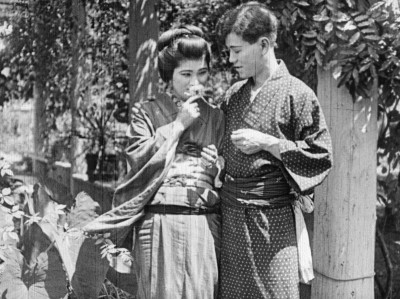
The Oath of the Sword
Recently Restored
Screening on Film
With Numa Hisa, Mori Tomi, Akashi Kohano.
US, 1914, 35mm, black & white, silent, 31 min.
Print source: George Eastman Museum
Considered lost until its discovery in 2016, The Oath of the Sword was produced in 1914 by a company described by Moving Picture World as the “first company in America to be owned, controlled and operated by Japanese.” Based in Los Angeles, the Japanese American Film Company was among several similar independent film companies established by Japanese immigrants during a period when the American film industry had yet to become Hollywood as we know it. The Oath of the Sword is the earliest known Asian American film production and illuminates a largely unknown chapter in American film history—only now being recovered via the rediscovery and restoration of films like The Curse of Quon Gwon (Marion Wong, US, 1916) and The Dragon Painter (William Worthington, US, 1919) starring Hayakawa Sessue.
The Oath of the Sword tells the story of young lovers separated as the ambitious young man, Masao, leaves his lover Hisa to study abroad at the University of California, Berkeley. Masao becomes a success at the university, a popular student and a star athlete who dominates in track and swimming competitions. Left to care for her ailing father and unable to cope with her solitude, Hisa eventually betrays Masao and marries another man. Upon Masao’s return to his native Japan, Hisa fulfills “the oath of the sword” (katana) and kills herself. Following the conventions of Madame Butterfly, in which a tragic interracial romance ends with suicide, the character Hisa is the fallen Japanese woman fulfilling her seemingly inevitable destiny by ending her life.
Of interest for contemporary viewers is the film’s setting on the California campus, as well as the first onscreen appearances of Abe Yutaka (1895-1977) who was later cast in The Cheat (Cecil B. DeMille, US 1915) and The Willow Tree (Henry Otto, US 1920). His early career included not only The Oath of the Sword but also a role in Lotus Blossom (1921) by James B. Leong and his Los Angeles-based Wah Ming Motion Picture Company. Later on, Abe returned to Japan and developed an influential career as a phenomenally successful and respected writer, director and producer of Japanese cinema. He is credited with directing some sixty-six films from Shohin eiga-shu: Pan (Japan 1925) to his final film Inochi no asa (Japan 1961). The Oath of the Sword is also significant for its casting of Japanese actors to play Japanese film characters, a major departure from industry practices of “yellowface” in films of this era like Madame Butterfly (Sidney Olcott, US 1915). These innovations in casting were emphasized in contemporaneous publicity materials. – Denise Khor, Northeastern University





